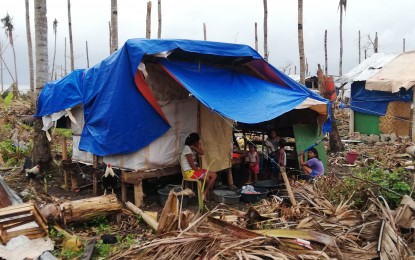
GROUND ZERO. A makeshift house built by typhoon survivors in Limasawa Island in Southern Leyte in this Dec. 27, 2021 photo. Residents here demonstrate resilience despite crisis. (PNA photo by Sarwell Meniano)
LIMASAWA, Southern Leyte – Typhoon Odette’s fierce winds destroyed houses and shattered the livelihood of thousands of residents in this small island, but their will to rise up from the rubble stood firm.
Antonio Oposa, 49, turned emotional when waves whipped by powerful winds washed away their house in Magallanes village, the site of the First Mass in the Philippines held 500 years ago.
“I could not do anything while seeing our house swept away by chest-deep waves. I cried after the typhoon, but I am still happy that all of us survived,” Oposa told the Philippine News Agency.
Just a stone throw away from their house is a tall pilgrimage center still under construction designated as the community’s evacuation center where Oposa’s family and hundreds of residents took shelter.
Within five hours at that time, over 4,000 coconut trees in a farm under his watch were either uprooted or sheared, destroying their main source of livelihood.
“I have to return to my farm and see what else I could recover. I turned emotional seeing the massive destruction, but life must go on. My plan is to plant vegetables to support my family’s needs,” said Oposa, a father of 10.
Three days after the storm, he built a makeshift house out of debris and a tent donated by the US Agency for International Development (USAID).
In Triana village, 90-year-old Suzano Pagangpang re-opened his community store with the help of his children a few days after big waves destroyed their house built near the shore.
“As one of the oldest residents in this village, I could not recall a typhoon as strong as Odette. The roof was blown away and we didn’t know where to hide since there was seawater and the flood. It was very scary, but we are happy that we are still alive,” said Pagangpang with a smile.
His store is now opened, making biscuits, crackers, and unrefrigerated soda drinks available to debris removers in the community hired by the government particularly by the Department of Labor and Employment for a 10-day job.
In the town’s upland village of San Agustin, over 20 families with roofless houses remained in classrooms designated as evacuation centers. Among them is the family of Janeth Tapin, 43.
“We spent our Christmas here and our wish for the New Year is to celebrate it in our house,” Tapin said.
Everyday, Tapin has been spending hours at the covered court waiting for the chance to receive a free tent from the USAID and relief goods from the government and private donors. Her husband, Marvin went on finding woods to rebuild their house.
Mayor Melchor Petracorta said they have been convincing people to find hope amid the crisis and focus on rebuilding instead of worrying.
"All we want is faster recovery. I told the people to help each other rise up. We need help from the national government and non-government organizations to restart our livelihood since we cannot just depend on relief goods,” Petracorta said.
Due to pre-emptive evacuation, the town has only one typhoon-related death and injuries.
The 6th class town with a population of over 6,500, has a calamity fund of PHP800,000 this year with over PHP300,000 already spent for pandemic response.
Presently, the entire island town has no electricity while its water distribution system is down. The power shutdown has stopped the water pump from working, forcing families to walk for kilometers to fetch clean water.
The diesel-powered generator by the National Power Corporation was not damaged, but majority of electric posts were either toppled or destroyed.
“I asked help from the National Electrification Administration since we are not a priority for repair considering the massive damage of distribution lines in the mainland,” Petracorta added.
Limasawa Island, the smallest town in the province of Southern Leyte is known to be the site of the First Catholic Mass in Asia, officiated on Easter Sunday, March 31, 1521, by Father Pedro de Valderrama under the fleet of Ferdinand Magellan. (PNA)
